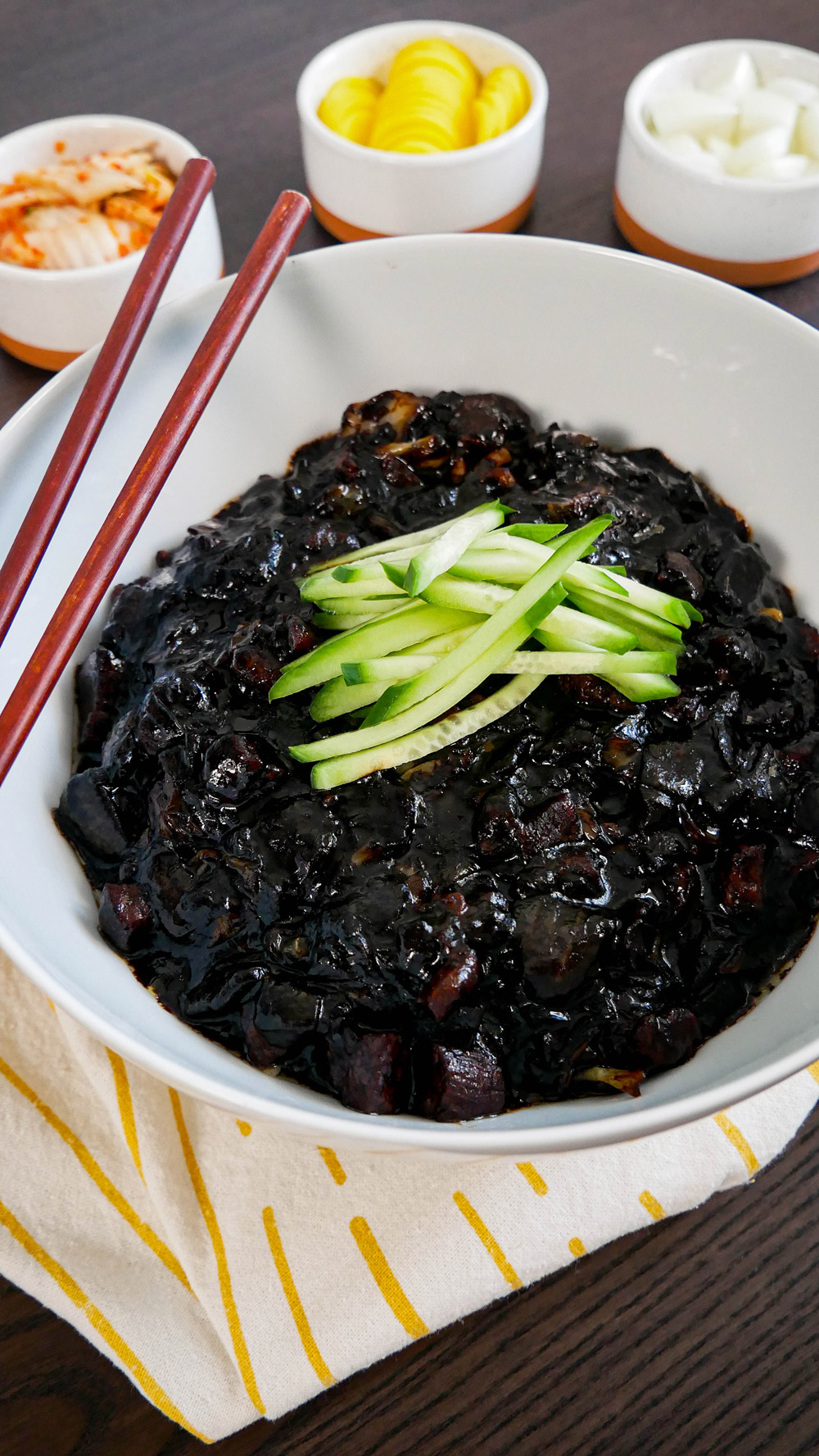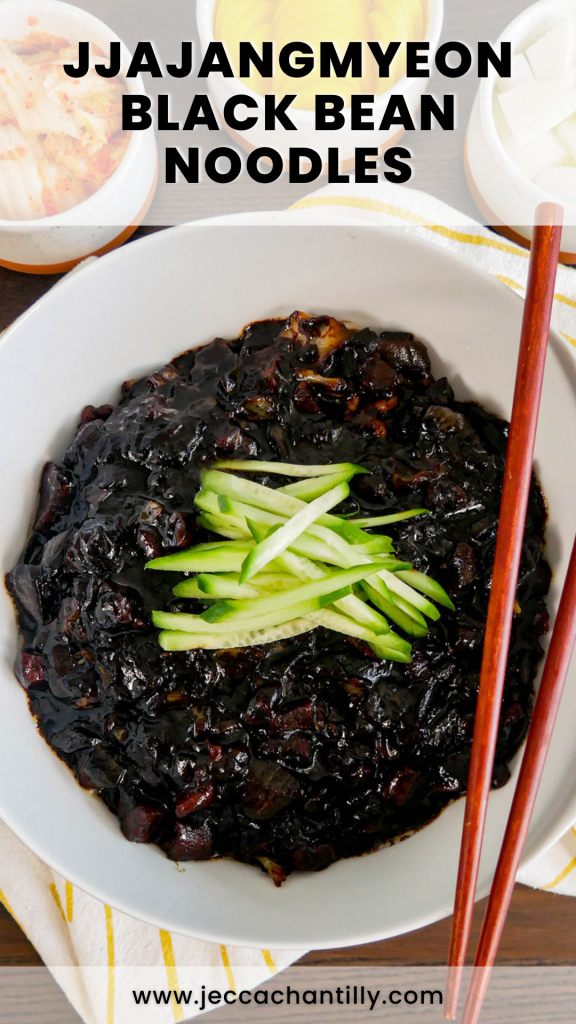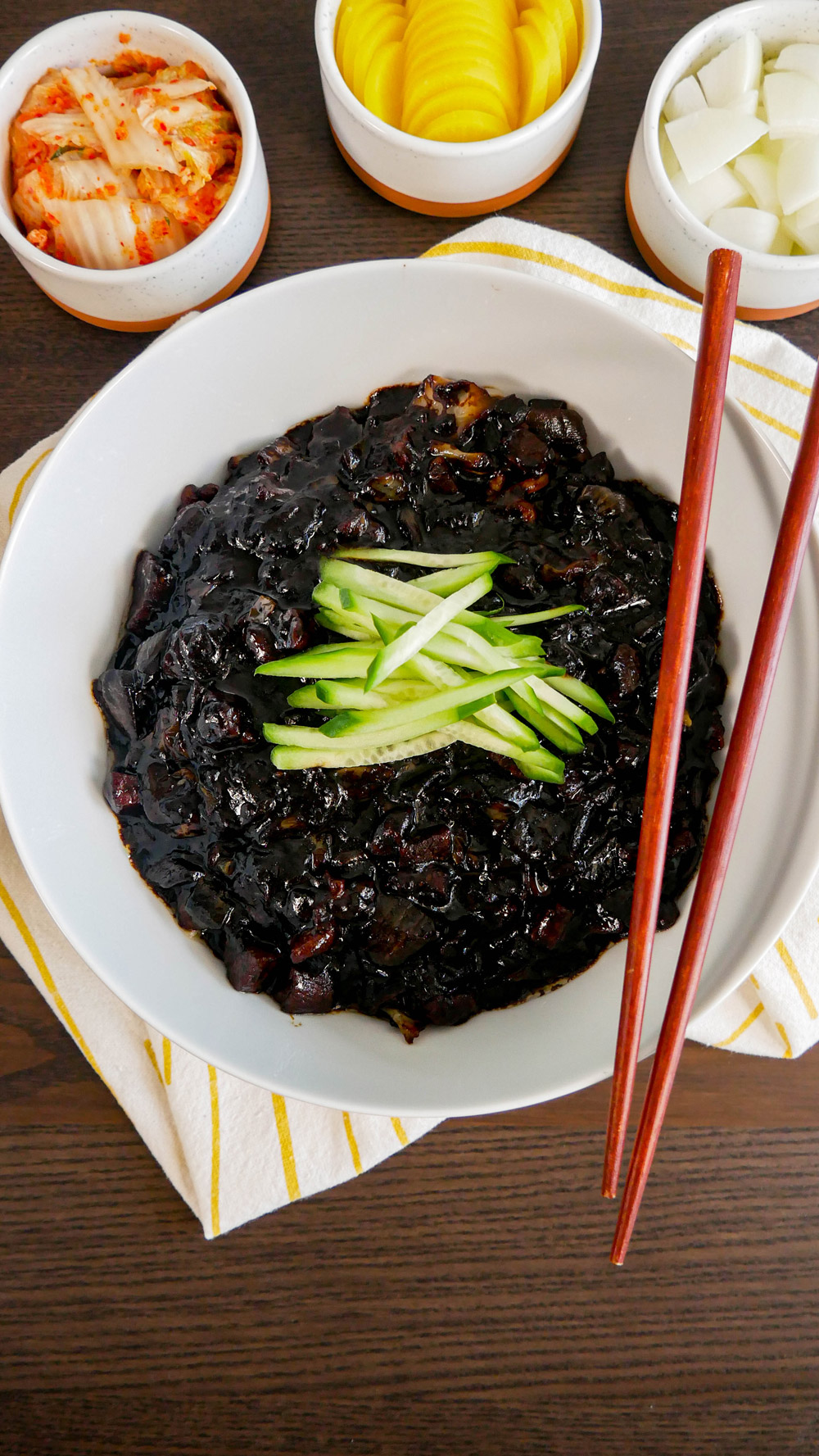When I visited Korea, the very first thing I did was order a bowl of jjajangmyeon! My mom always talked about how she missed the jjajangmyeon in Korea and it always looked so good in Korean dramas so I knew it had to be my first meal there.
Jjajangmyeon is a Korean-Chinese dish that’s commonly served alongside ‘jjampong‘ (spicy seafood noodle soup) and ‘tangsuyuk‘ (sweet and sour pork). Being half Korean and half Chinese, I feel a sense of pride in Korean-Chinese cuisine. I grew up eating it with my parents all the time when I was younger so it’s a very nostalgic meal. To this day, my dad will always make it a point to share the story of a 5-year-old me with ‘jjajang‘ sauce all over my face. It’s a core memory for my parents, which makes it that much more special to me.
Now that I’m back in New York, I needed a way to get my jjajangmyeon fix so I knew I had to recreate it at home. After a few rounds of testing, I can confidently say that this is just as good or even better than the restaurants! It makes me super happy that I can make this at home whenever I want! Plus, it’s really easy to make.
Why you’ll love this recipe
If you’ve never had jjajangmyeon before, get your tastebuds ready for the ultimate ride. Black noodles may seem a little intimidating at first, but once you get a bite you’ll be surprised why it’s loved by so many people.
The rich and hearty black bean sauce with the chewy and bouncy noodles is such a great combo. And when you have it with ‘danmuji’ or pickled radish, it’s even better!
For this recipe, I like using sliced pork neck (or shoulder) to make it heartier but you can substitute it with any other protein or skip it completely. The same goes for the vegetables in this dish. I like using cabbage and zucchini but you can easily swap or add your favorite veggies including carrots and potatoes. I think onions are essential in the ‘jjajang‘ sauce so don’t skip it!
Now as you can see, jjajangmyeon is very customizable so as always, make it how you like!
How do I prepare Jjajangmyeon Black Bean Noodles?
Jjajangmyeon is very easy to prepare – even if you don’t have any cooking experience. To get started, follow my instructions below!
Step 1: Prepare the pork
Cut the pork into bite-sized pieces. Then, marinate it in mirin, salt, and white pepper. Set aside for 10 minutes.
Step 2: Prepare the black bean paste
In a pan, fry the black bean paste (chunjang) with ¼ cup of oil over low heat for about 5 minutes or until it’s glossy. Be sure to stir and mix the black bean paste so it cooks evenly. Transfer to a bowl and set aside.
Step 3: Cook the ingredients
With the leftover oil in the same pan, saute the scallions and chili peppers for 1 to 2 minutes over medium heat. Add the pork and saute until it’s fully cooked. Then toss in the onions, cabbage, and zucchini, and let them cook for 2 to 3 minutes. Add the black bean paste and mix to coat the vegetables evenly.
Once that’s done, pour in the water and bring to a boil until the vegetables are tender (about 5 to 10 minutes). Add the sugar, starch slurry, and MSG to finish the sauce.
If the sauce is too loose, you can cook it down for a couple more minutes or add more starch slurry until it reaches your desired thickness. If you find that the sauce is too thick, add a splash of water to loosen it up.
Step 4: Cook the noodles
In a large pot with boiling water, cook the noodles according to the package instructions. Then, drain the water, rinse the noodles with cold water, and drain again.
Step 5: Serve while hot!
Place one serving of the noodles into a bowl and pour a generous amount of sauce on top. Don’t forget to garnish it with cucumbers, and enjoy!
Cooking Tips for Jjajangmyeon Black Bean Noodles
Preparing black bean noodles doesn’t require any fancy skills, but here are a few tricks you can keep in mind to make them perfect and delicious every time:
- Be sure to keep an eye on the black bean paste (chunjang) so it doesn’t burn!
- Instead of water, you could also use chicken broth or beef broth for a more flavorful sauce.
- Adding the MSG is optional but highly recommended. It’ll enhance the flavors of the sauce and make it taste 10 times better! Trust me on this.
- After cooking the noodles, don’t forget to rinse them under cold water so they get that chewy and bouncy texture!
Ingredient Substitutions
Pork neck: I prefer to use pork neck for this recipe because it has a good ratio of meat to fat, but you can also replace it with pork shoulder or belly.
Black bean paste (chunjang): black bean paste carries the majority of the flavor in this dish. It’s bitter in its natural form but once it’s cooked down, it turns into a rich, luscious sauce. When making jjajangmyeon, there is no substitution for black bean paste.
Mirin: mirin adds a slightly sweet flavor to the pork and it also masks any unpleasant odors, but you can also use sake or cooking wine.
White pepper: I like using white pepper because it adds a subtle hint of spice and earthiness. You can also substitute white pepper with black pepper.
Cabbage: In addition to the onions, cabbage also adds a natural sweetness to the sauce. You can replace it with any leafy greens of your choice, including bok choy, or omit it completely. Just make sure to add more onions if omitting the cabbage.
Zucchini: zucchini also adds some sweetness and texture to the sauce. It can be substituted with carrots or potatoes.
Long green pepper: I love a little spice in my food so I like to add long green peppers for a subtle kick of heat. You can substitute long green peppers with jalapeno peppers, serrano peppers, or even Thai chili peppers!
Cucumber: Cucumbers provide a refreshing break from the thickness of the sauce and the spiciness of the peppers. To substitute cucumbers, you can use fresh zucchini, radish, or sliced scallions.
Potato starch: potato starch helps to thicken up the sauce so it can coat the noodles evenly, but if you need to substitute it, you can also use cornstarch.
Frequently Asked Questions
Why is my jjajangmyeon bitter?
If your jjajangmyeon turns out bitter, there might be only two possibilities for this. One is that the black bean sauce is burnt or you skipped the step of cooking the black bean paste. Raw black bean paste originally tastes bitter, which is why it’s important to cook it down in oil. You’ll know it’s done once it has a shiny sheen, which usually takes about 5 minutes. With that being said, resist the urge to take the black bean paste off the heat before it turns shiny. You’ll know the black bean sauce is burnt or overcooked when it clumps up into a hard ball. If this happens, you’ll need to discard it and start over.
If the ‘jjajang’ sauce is still bitter, you can add more sugar to balance it out with the sweetness. Start by adding 1 teaspoon at a time until you’re happy!
What are jjajang noodles made of?
For this recipe, I’m using fresh thick wheat noodles which are usually labeled as ‘jjajang noodles’ on the package. Generally speaking, the noodles are made of wheat flour, water, baking soda, and salt however this can vary depending on the brand. You can buy ‘jjajang‘ noodles at your local Korean market like H Mart.
While you can also use dried thick wheat noodles, I personally prefer using fresh ones. I love the chewy and bouncy texture that comes with fresh noodles.
What is black bean paste (chunjang) made of?
Fermented black bean paste or ‘chunjang’ is made from soybeans, wheat flour, and caramel that’s fermented to develop its deep and rich flavor. As mentioned before, ‘chunjang‘ has a bitter and salty flavor that will improve once it’s properly cooked. You can find fermented black bean paste in glass jars or tubes at Korean markets. Just be sure to check the labels – some packaging will say ‘jjajang’ but the one you want to get is ‘chunjang’. Once opened, black bean paste can stay fresh for up to 3 months as long as you keep it tightly closed and stored in the fridge.
Can you reheat Black Bean Noodles?
Jjajangmyeon sauce reheats beautifully as long as you store it separately from the noodles. You don’t want to store the noodles and sauce together otherwise, the noodles will absorb the sauce and get very mushy. To reheat the sauce, place it in a pot over medium heat and bring it to a simmer until thoroughly warmed. If the sauce is too thick, you can add a splash of water to loosen it up. For the noodles, I recommend using freshly cooked noodles.
What side dishes can you enjoy with Jjajangmyeon Black Bean Noodles?
Side dishes (or banchan) are essential for any Korean meal, especially jjajangmyeon. Here are some common side dishes that you can enjoy with these delicious black bean noodles!
Kimchi – a classic Korean side dish! The spice and tang of kimchi will cut through some of the richness of the black bean sauce. To make kimchi at home, check out my Geotjeori Kimchi or Homemade Kimchi recipes!
Pickled Radish – also called ‘danmuji’ in Korean, this is yellow-color pickled radish is essential when eating jjajangmyeon. In my opinion, jjajangmyeon is incomplete without this radish as a side dish. I don’t bother making it at home because the ones they sell at the market are already so delicious! You can find it at any Korean market but you can also find it online here!
Chopped white onions – if you’re not familiar with jjajangmyeon and how it’s served at the restaurant, this one might seem a bit odd – but it works. Chop up some white onion in 1-inch pieces, pour a little bit of white vinegar on top and there you have it! You’ll get a refreshing crunch from the onions while you eat the soft and chewy noodles.
Looking for more easy Korean-inspired recipes? Check these out below:
- Dduk Guk – Korean Rice Cake Soup
- Japchae Dumplings
- Spicy Seafood Noodle Soup
- Korean Seafood Pancake
- Korean Silken Tofu
- Spicy Whelk Noodles
- Tteokbokki – Spicy Rice Cake
- Sujebi Noodles
- Seafood Soondubu

Jjajangmyeon Black Bean Noodles
Ingredients
Noodles
- 400g fresh thick wheat noodles
- 6 cups water for boiling
Sauce
- 8 oz pork neck substitute with shoulder or belly
- 1 tbsp mirin substitute with cooking wine or sake
- 1/4 tsp salt
- 1/4 tsp white pepper
- 1 ½ cups onions diced
- 1 ½ cups cabbage diced
- 1 ½ cups zucchini diced
- 1 long green pepper or jalapeno sliced 1/4 inch, diagonally
- 2 scallions chopped
- ½ cup fermented black bean paste chunjang
- 1/4 cup neutral oil
- 1 tbsp sugar
- 2 ½ cups water for more flavor, use low-sodium chicken or beef broth
- 1 tsp msg optional
Starch Slurry
- 1 tbsp potato starch or cornstarch
- 2 tbsp water
Garnish
- ½ cucumber sliced
Instructions
- Cut the pork into bite size pieces. Marinate in mirin, salt, and white pepper for 10 minutes.
- In a pan, fry the black bean paste with ¼ cup of oil over low heat for about 5 minutes or until glossy. Transfer to a bowl and set aside.
- Using the leftover oil in the same pan, sautee the scallions and peppers for 1 to 2 minutes over medium heat. Add the pork and saute until fully cooked.
- Toss in the onions, cabbage, and zucchini and cook for 2 to 3 minutes. Add the black bean paste and mix to coat the vegetables.
- Pour in the water and bring it to a boil until the vegetables are tender. Add the sugar, starch slurry and msg to finish the sauce.If the sauce is too loose, you can cook it down for a couple more minutes or add more starch slurry until it reaches your desired thickness. If you find that the sauce is too thick, add a splash of water to loosen it up.
- In a large pot with boiling water, cook the noodles according to the package instructions.
- Drain and rinse the noodles in cold water and drain again.
- Place one serving of the noodles into a large bowl. Pour a generous amount of sauce on top.
- Garnish with cucumbers and enjoy!
Notes
2. I prefer using pork neck but you can use other cuts like pork belly and shoulder.
Pin & save this recipe for later!

